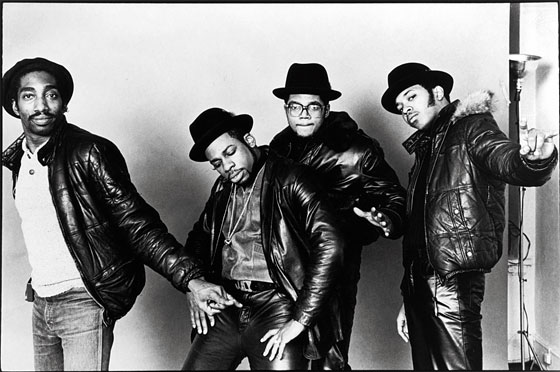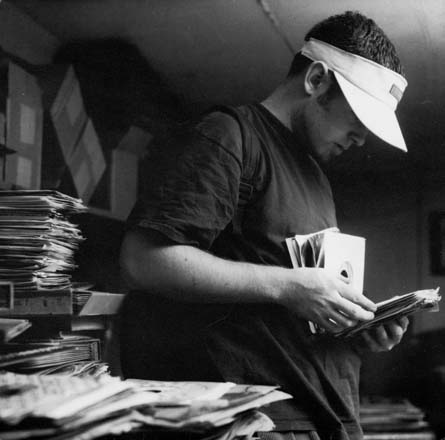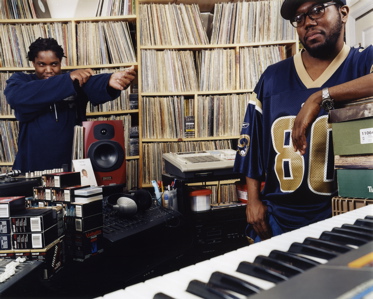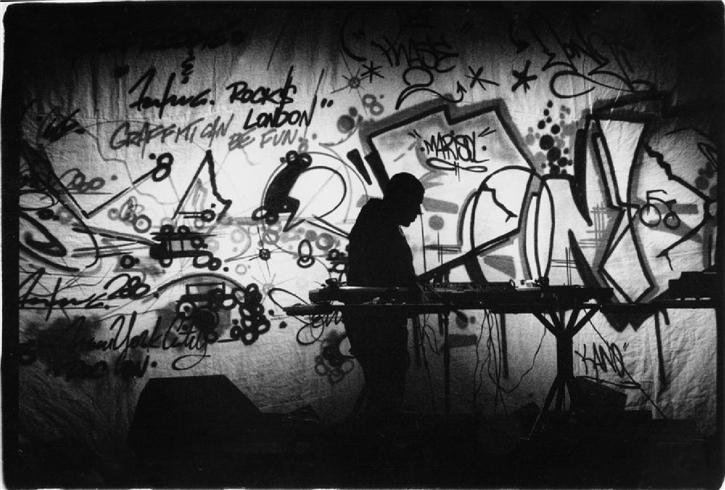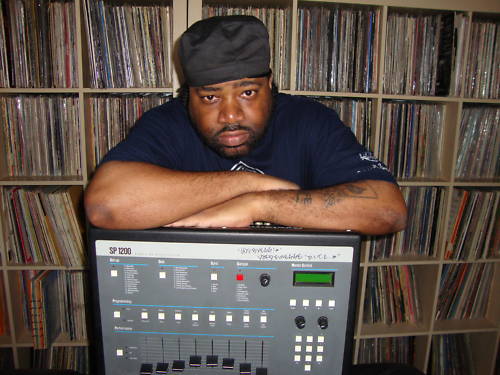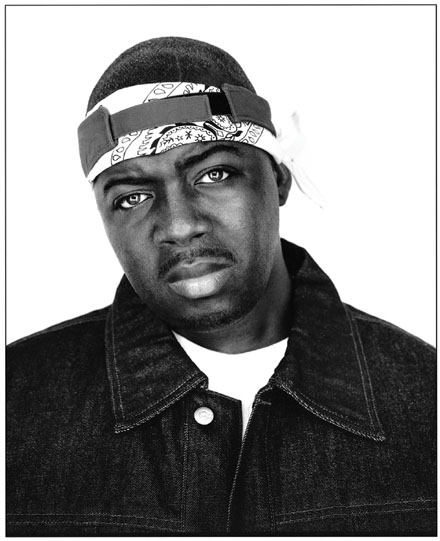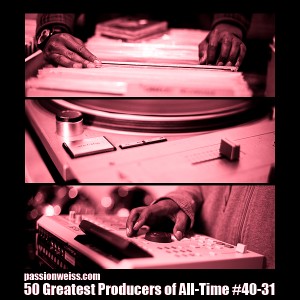 See Also: The 50 Greatest Producers of All-Time #50-41
See Also: The 50 Greatest Producers of All-Time #50-41
The Greatest Producers of All-Time: Honorable Mention
40. Battlecat
At the risk of excluding forgotten pioneers, you can trace the local roots of LA hip hop production to five names: Dr. Dre, Joe Cooley, Egyptian Lover, Arabian Prince, and DJ Battlecat. The latter broke in as a 16-year old DJ in the early KDAY era and remains one of the most influential architects of West Coast rap. When Snoop went into the studio last month to record tracks for Detox, he brought Quik and Battlecat. Other than the absentee Dr, there is no one else still standing. Battlecat’s first credit came on 1988’s “DJ-N-Effect,” an electro-rap jam that was part JJ Fad, part Egyptian Lover, and part proto West Coast turntablism. From there, he went straight to the throne as the city’s go-to-producer. Dre and Cold 187um of Above the Law can fight about who invented G-Funk, but it was Battlecat who executed the plot to dominate half a continent.
Examine the production resume: Lighter Shade of Brown, Penthouse Players Clique, W.C. and the Maad Circle, Domino, Space 1, Kam, Dru Down, Rass Kass, Kurupt, Snoop, E-40, Mr. Mike, Lucy Pearl, Xhibit, Dogg Pound. Battlecat did it all. He made hits like “Ghetto Jam,” “We Can Freak It,” and “High Come Down” that will live forever on left coast radio. When the Bloods and Crips came together to record an album, they called Battlecat for the single. He even made a track with Tom Jones, thus trouncing Dre and his Burt Bacharach fixation. If Andre Young was the prophet, Battlecat was the apostle. Listen to the mix below — you have been warned. —Jeff Weiss
MP3: DJ Mike Biggs- Tribute To Westcoast Legendary Producer Battlecat
39. Larry Smith
The notion of anybody being “slept on” in the age of the internet seems somewhat ridiculous, but if anybody still qualifies it’s Larry Smith. Responsible for the production of the first two Run DMC albums as well as hits with Whodini, Smith’s work changed the course of mainstream rap music and redefined the genre. Who knew? As rap music gradually morphed into something bigger in the early 80s it was his drum machine beats that did away with the excess and made the music raw.
Smith’s particular aesthetic was relatively quickly superseded as sampling technologies allowed the expansion of the musical palette from which producers could source sounds, but the underlying spirit of rap as a stripped down force of rebellious youth had been set in motion through his innovation. That’s quite a legacy to be forgotten and Darryl, for one, is outraged Rightly so. — Dan Love
MP3: Run DMC – Sucker MCs
MP3: Whodini – Five Minutes of Funk
38. DJ Shadow
It says a lot about DJ Shadow that his name still holds an almost mythical status with many, given the patchy quality of his records over the past five years. The Outsider put a significant dent in Shadow’s fabled profile, and it looks like The Less You Know, The Better might go some way to finishing off the job, but Josh Davis’s reputation as a producer will remain stacked on two exceptional, albeit very different records.
The first is Endtroducing. Slowly pieced together in 1996 using an MPC60, two turntables, and Dan the Automator’s copy of Pro Tools, this record remains Shadow’s murky, masterful calling card. Endtroducing’s party trick is of course the fact that it’s totally built from samples. Shadow essentially stretched the hip-hop production idiom as far as it could possibly go: neglecting any live instrumentation, but in doing so creating a record that was fundamentally different to its own building blocks. It almost single-handedly killed off the ‘sampling is stealing’ argument that had for so long plagued rap music. Unfortunately, the trap with Endtroducing is to get so caught up in the technique of the record that you forget about the emotion: a spooky journey through 20th century pop-culture, funereal pianos and screwed organs wrapped up with ghostly vocals and mysterious film samples. It introduced half a generation of casual listeners to hip-hop and helped legitimize the artistic merits of turntablism.
With all this in mind, 2002’s The Private Press was always going to receive short thrift from critics and listeners. But Shadow’s sophomore has grown in stature of the years, and as his more recent releases have faltered, this is the record that you point to in hope of a better future. Sample-based, but with further input from both vocalists and digital sources, The Private Press is Shadow as composer, sewing disparate parts together to create a compelling whole, one that features a succinct and focussed audio narrative. It’s the kind of record you let play out after you leave the house, because cutting its sequence short seems so wrong.
If there was an indicator of the difficulties that would plague Shadow’s later work, it was the 1998 UNKLE release Psyence Fiction. An impressive but often distant listen, it showed up the troubles Davis had with utilizing collaborators for his densely packed beats. It’s a problem that plagued the scattershot The Outsider, with its misfiring hyphy and bizarre descent into alt-rock territory. It means that in 2011, Davis is not so much enigmatic as he is mercurial. He makes this list because he’s a game changer, but the egoism inherent in DJ Shadow’s desire to constantly buck people’s expectations means he’s in danger of losing the magic his name conjures and, in the words of this site’s Barry Schwartz, simply becoming a dude named Josh. —Matt Shea
MP3: DJ Shadow – Midnight In A Perfect World
MP3: DJ Shadow – Six Days
37. Showbiz
Showbiz’s catalogue is embedded with a sense of true hip hop legacy. Hailing from the South Bronx both his methods and sound drip with tradition and heritage. A renowned digger, his initial output was hard and unabashedly funky, screeching horns over manic percussion. ‘Still Diggin’’ is a prime example of both the philosophy and the sound, samples dropping in and out of a groove with fierce momentum. It’s the kind of thing that spontaneously makes you say ‘Holy mackerel!’
The work with AG and other artists from around 1995 onwards is slightly different, fewer loops and with less frenetic drums. Goodfellas, Show & AG’s sophomore effort, features some of his darkest work, highly aggressive and deliciously dark, but elsewhere Show maintained a more inclusive sound. ‘A Friend’ is perhaps the best example from this period, warm strings and keys offset with a punchy but not overwhelming drum track, a lesson in NY-centric mid 90s production where the beat drops just where it’s supposed to: there. —Dan Love
MP3:KRS One – A Friend
MP3: Showbiz & AG – Still Diggin
36. No ID
 No I.D. is the rare producer who evolved past his niche and kept going. He began as a disciple of the jazz-inflected East Coast sound, producing Common’s first three records with a heavy boom bap slant. No I.D. soon branched out with freelance work for G-Unit, Jay-Z and Ghostface and began co-producing pop singles like Alicia Keys’ “My Boo” with Jermaine Dupri. He not only mentored Kanye but began co-produced with him, from 808s and Heartbreaks onward, becoming an integral part of Mr. West’s sound in recent years. He’s equally adept at bangers and ballads, dropping glossy pop tracks like Big Sean’s “My Last” then crafting a Tunnel thumper like “Primetime” for the two biggest rappers in the world without a bit of hesitation. It’s remarkable that a producer rocking jazz samples in ’94 could progress his sound to encompass the stiff snap drums and creepy vocal samples of “Ready Set Go”. No I.D. represents the possibility of longevity in hip-hop. – Aaron Matthews
No I.D. is the rare producer who evolved past his niche and kept going. He began as a disciple of the jazz-inflected East Coast sound, producing Common’s first three records with a heavy boom bap slant. No I.D. soon branched out with freelance work for G-Unit, Jay-Z and Ghostface and began co-producing pop singles like Alicia Keys’ “My Boo” with Jermaine Dupri. He not only mentored Kanye but began co-produced with him, from 808s and Heartbreaks onward, becoming an integral part of Mr. West’s sound in recent years. He’s equally adept at bangers and ballads, dropping glossy pop tracks like Big Sean’s “My Last” then crafting a Tunnel thumper like “Primetime” for the two biggest rappers in the world without a bit of hesitation. It’s remarkable that a producer rocking jazz samples in ’94 could progress his sound to encompass the stiff snap drums and creepy vocal samples of “Ready Set Go”. No I.D. represents the possibility of longevity in hip-hop. – Aaron Matthews
MP3: Common – Resurrection
MP3: Killer Mike – Ready Set Go (Remix ft. T.I. & Big Boi)
35. Da Beatminerz
Da Beatminerz work in a secret waterside cavern where Save The Whales pays them top dollar to broadcast their beats through the ocean to get humpback whales to have sex. Above sea level, Beatminerz production serves a rarefied strand of New York rap that draws an unseen murkiness out of lo-fi jazz loops and all-consuming bass lines. Black Moon’s Enta Da Stage was a work of darkness without the superficial mafioso tropes that hadn’t yet hijacked the city. The horn samples on “Niguz Talk Shit” and “I Got Cha Opin” are are some of hip-hop’s best known melodies; the enveloping bass invites Buckshot’s rasp and the chanted choruses to cut through it. Da Beatminerz weren’t masters of bleakness or foreboding, but rather subterranean grooves that vibrate through your feet and up your spine. “Who Got Da Props” and “Buck ‘Em Down” radiate spirited boom bap momentum and Smif-N-Wessun’s “Bucktown” rivals “They Reminisce Over You (T.R.O.Y.) ” in ruminative nostalgia. The Boot Camp Clik and Da Beatminerz are usually overlooked in favor of their era’s more distinctive and charismatic movements, but they deserve their due respect before they die of dust inhalation. – Evan Nabavian
MP3: Smif-N-Wessun – Bucktown
MP3: Black Moon – I Got Cha Opin
34. MF Doom

Just as there are a plurality of Doom personas, there are a multitude of Doom production touches, each of which can be a key to identifying a track produced by Dan Dumile. The man’s in a mask for a reason; it makes a shift in identity as easy as drinking a brew (as irate concertgoers have found out many times.) But he leaves his metal fingerprints all over anything he creates, which makes identifying a Doom track as easy as consulting this simple checklist:
1. Cartoon/Video Game Samples. If you hear a woman shrieking while a staid hero reacts in shock to the presence of a villain, if bleeps, bloops, whirrs and hums abound, if the sound sounds like it was made by computers in the nineties, there’s a good chance that Doom produced it.
Examples: ” “The Time We Faced Doom,” “Galangal Root” “It Ain’t Nuttin’
2. Soul over Soft Percussion. A simple loop over skittering drums, often involving horns, short studies in syncopation that sound equally good as two minute instrumentals as they do with vocals over them—that’s Doom.
Examples: “Rhymes Like Dimes,””Zatar,” “Mugwort,” “Orris Root Powder”
3. Weeded as Hell. This one is simple enough. These beats were clearly created by the influence of M-A-R-I-J-U, A-J-U-A-N-A, mari, juana, marijuana.
Examples: Everything.
If those elements are present, it’s a Doom beat.*
*Or a Madlib beat. Sorry. —Jonah Bromwich
MP3: MF Doom – Rhymes Like Dimes
MP3: MF Doom – Dead Bent
33. Afrika Bambaataa
People still argue over who acted as the harbinger of hip-hop in 1970s New York. Perhaps it was Herc with his Herculords, the massive sound system that drove many a bumping Bronx block party. Or maybe it was Gandmaster Flash, a bookish background and Quick Mix Theory making him the card-carrying nerd of early rap music.
The third option is Afrika Bambaataa. And while Herc had his sound and Flash the technique, it was Bam who brought the records. He was notorious for his crate-digging and eclectic taste in music, a passion he inherited from his mother in a family that kept close to its Caribbean heritage. Extensive record collections often prove the common thread between many great hip-hop producers, and it’s the reason Bam makes this list – in particular the way he manipulated those influences on his seminal 1986 LP, Planet Rock: The Album. Of course, Planet Rock isn’t a true album – it’s more a collection of Bambaataa singles from the early 80s – but the fact that it piled together “Planet Rock”, “Looking For The Perfect Beat”, and “Renegades Of Funk” makes it an important document of early rap music.
Of those three cuts, it’s the epic, game-changing title track that confirms Bambaataa’s place in the storied history of hip-hop, and goes straight to the heart of the innovation he displayed early in his career. The krautrock elements are obvious, Kraftwerk’s “Trans-Europe Express” being re-recorded in the studio by Bambaataa and fellow producer Arthur Baker, whilst synth-pop sprog Gary Numan and Parliament were also cited as having influenced the record. But out of everything Bam poured into “Planet Rock”, it was his interest in Yellow Magic Orchestra that would eventually prove the most important: the Japanese group were the first to use the TR-808, and by musical osmosis Bam brought the Roland drum machine straight into the hip-hop bloodline — Matt Shea
MP3: Afrika Bambaataa and the Soulsonic Force – Looking For The Perfect Beat
MP3: Afrika Bambaataa and the Soulsonic Force – Planet Rock
32. Lord Finesse
The Bronx’s Diggin’ in the Crates crew stood astride the early to mid 90s east coast scene like a hip-hop colossus, and to this day have a strong pull on the New York underground. Buckwild tends to come first when you think of producers and the Crates, particularly since the release of last year’s Nineteen Ninety Now. But it’s Lord Finesse who’s the beating heart of D.I.T.C., and his skill with the microphone often muddies the waters when considering an exceptional career behind the boards.
Indeed, rapping was something Finesse simply fell into, his distinctive, slack-jawed delivery turning heads with 1990’s Funky Technician and earning him the reputation of being a notorious ladies’ man. But after that record’s success, Finesse had a chance to sit down and invest himself in the musical realm of hip-hop, forming Funky Man Productions and cutting tracks with The Notorious B.I.G., Big L, and Fat Joe, as well as R&B luminaries such as SWV, Jeff Redd, and Caron Wheeler. It was 1996’s The Awakening that confirmed him as a producer of note. Finesse’s beats are big and bass-heavy, refined yet lackadaisical, and carry a degree of depth that’s not always apparent upon first listen. The Awakening is the kind of record made to road test stereos, its complexities and depth of bass tone brought out by a superior sound system.
Still, the ultra-smooth, forward-thinking, funk-laden qualities of Lord Finesse’s productions are easily recognisable regardless of your aural circumstances, particularly when enjoyed through a haze of weed smoke. It’s evident in a resurgence of interest in Finesse’s work, particularly in the wake of the Mac Miller’s YouTube phenomenon, “Kool Aid & Frozen Pizza”, which was built upon the beat from “Hip 2 Da Game”. Miller has since approached Finesse personally to provide beats for a mixtape: Finesse politely turned down the Pittsburgh teenager, but the spillover has been obvious. You’re left wondering how long it will be before the Funky Man says yes to such a project. —Matt Shea
MP3: Lord Finesse – Hip 2 Da Game
MP3: Big L – Street Struck
31. Erick Sermon
“You Gots to Chill.” There aren’t four better words in the English language that better embody the production ethos of Erick Sermon (though a strong case could be made for “rough, rugged, and raw”). In the late ‘80s, a time when most beatmakers were scrambling to unearth every last break out of James Brown’s discography, Sermon pushed the envelope by pushing the tempo down, eschewing dance-friendly breakbeats for a chunky soup of trunk-rattling bass melted over the digitized grooves of Zapp and Parliament. His chops only became more refined during the ‘90s as Sermon’s mid-tempo basement funk morphed into a kind of menacing nocturnal pulse, relocating from the backs of jeeps to crumbling warehouses and abandoned subway terminals. Beat patterns are minimal, melody takes a back seat to hypnotically thumping bass, and tempos rarely deviate from a cozy 94 beats per minute: this is the framework through which Sermon channeled his muse.
His omnipotence from roughly ’92 through ’95 was virtually unmatched: I can remember exactly where I was when I was first floored by EPMD’s “Crossover” video on BET’s Rap City; my initial adrenaline rush upon hearing Redman’s “Time 4 Sum Aksion” was dizzying in its intensity; hell, I even thought the gritty Sermon-helmed B-side “Rock Bottom” was far and above the rest of the material K-Solo’s Time’s Up. Like many of his peers, Sermon eased into mediocrity when he transitioned from samplers to synthesizers, but I’d wager that if you blessed him with a few basic, garden-variety ingredients – chopped Skull Snaps drums, a filtered Bob James bass line, and ESG’s “UFO” – and an MPC-60 he’d still have your head nodding instinctively in a matter of minutes. —Floodwatch
MP3: EPMD – You Gots to Chill
MP3: Erick Sermon – Hostile (feat. Keith Murray)


